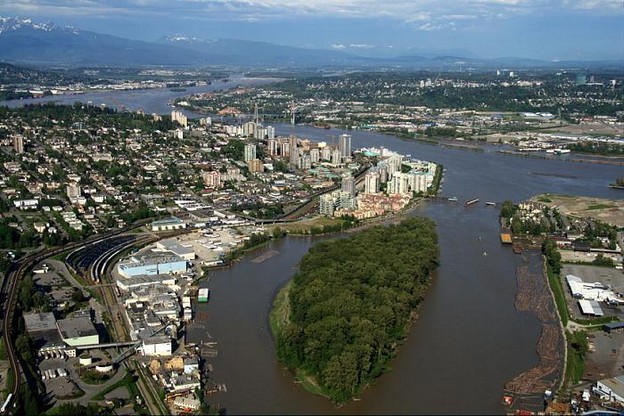Cecily Nicholson's 'From the Poplars'

City of New Westminster is one of several cities and municipalities comprising the Greater Vancouver Regional District (GVRD), also called Metro Vancouver. Named by Queen Victoria in 1859 after her favourite part of London and hence nicknamed the Royal City, New Westminster was the first Canadian city West of the Great Lakes. The image above shows Poplar Island situated in the Fraser River, with New Westminster built on the West (left) bank of the river. Poet and activist Cecily Nicholson's second book of poetry, From the Poplars (Talonbooks, 2014), documents the history of this small depopulated island as traditional Qayqayt land, a former reserve, a smallpox quarantine zone, a ship-building site during the First World War, a base for the logging industry, now unused and lush with trees, in the present moment of the city’s waterfront redevelopment to expand retail and residential space.After years of living in Vancouver Nicholson moved to New Westminster just a few blocks from Columbia Street, a main artery of the city that runs alongside the railroad tracks that historically and presently serve industry on the Fraser River. Positing poetry as a form of accumulation, her long poem begins with how her inquiry to the City about the island results in a case of mistaken identity as she is presumed to be a potential buyer:
I could not explain my purpose other than to say:
“I am writing a book of poetry.” A minor purchase of property.
Mining dominant culture’s historical records, Nicholson poetically rehistoricizes archival documents so that exploitation of people and land by colonial enterprise and contemporary city is foregrounded:
The Waterfront Esplanade Boardwalk
magnificent waterfront
band landless
etched public art on the river
across the river and the view from the river
arrived at Yi Fao
“great chiefs”
memories of colonial memories
royal affiliation rule of celebration
another May Day baby
queen
neighbours fresh water Sunbeam Gallery
“The Queen acknowledges Sir Edward Bulwer-Lytton's letter
…She has chosen ‘New Westminster’ for the name of the
Capital of British Columbia.”
Emily Fedoruk, a poet and scholar born and raised in New Westminster, does site-specific research on how poetry is used by capital to culturalize public spaces of consumption. One site, Plaza 88, is a retail hub built around the New Westminster Skytrain station, topped with three residential towers. Plaza 88’s retail exterior incorporates text-based art that architect Graham McGarva says is intended to “tell the story of New Westminster, which included the land of the First Nations and the settlement of New Westminster.” McGarva’s narrative consists of a line from a poem he wrote, “In making Canada, a tented canopy set upon a hill”; a series of red and gray panels that spell in Morse code “New Westminster” and “Yi Fao,” a Chinese word for New Westminster meaning second city, so called because it was typical for Chinese migrants to first stop in Victoria on Vancouver Island before proceeding to a second city on the Mainland, New Westminister; and a quote from Qayqayt Chief Rhonda Larrabee's mother about their family's secret Indigenous heritage, “I will tell you once, but you must never ask me again.” Larrabee's mother was Qayqayt, a First Nation that lived along the Fraser River and was greatly reduced by a smallpox epidemic then dissolved by the government; she survived residential school survivor to spend her adult life in Vancouver’s Chinatown, passing as Chinese, hiding her ancestry from her husband and their children.
Fedoruk argues that Plaza 88 glosses over the violence of colonization and multiple concurrent First Nations land claims over Poplar Island, using Qayqayt First Nations and Chinese-Canadian history to add value to property that already commands some of the highest prices in the global real-estate market. For most viewers the Morse code gesturing to the Chinese community is unreadable, erasing the exploitation of Chinese labour in railroad building and other projects of the colonial enterprise. Chief Larrabee's discovery of her First Nations heritage and subsequent successful effort to have the Qayqayt Nation reinstated is only hinted at through her mother’s words, which are unreadable produced as they are in abstracted grey and white text. The only part of New Westminster’s story that is readable are the architect’s own words—a reference to the temporary shelters of the Royal Engineers who surveyed and mapped First Nations land for the empire. Just twelve miles away, homeless Indigenous people are exercising their land rights by sheltering at Oppenheimer Park tent city in Vancouver. Nicholson’s From the Poplars is a necessary disruption into what Fedoruk calls McGarva's “coordination of many stories towards one cohesive, colonizing end reduc[ing] the political specificities of the suburban community to pixels and ellipses,” pointing to the strategic appropriation and commodification of First Nations history in order to market the city.
Unceded west coast city: Vancouver